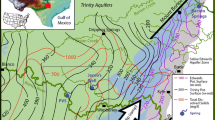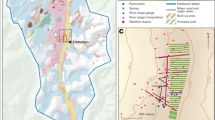Abstract
Understanding the processes controlling groundwater/surface-water interaction is essential for effective resource management and for protecting sensitive ecosystems. Through intensive monitoring of Chalk groundwater, shallow gravel groundwater and surface water in the River Lambourn, UK, using a combination of hydrochemical and hydrophysical techniques, a complex pattern of interactions has been elucidated. The river is broadly in hydraulic contact with the streambed sediments and adjacent gravels and sands, but these deposits are mainly hydraulically separate from the underlying Chalk at the site. The hydraulic relationship between the river and underlying alluvium is variable, involving components of groundwater flow both parallel and transverse to the river and with both effluent and influent behaviour seen. While the gravel aquifer is significant in controlling groundwater/surface-water interaction, its importance as a route for flow down the catchment is likely to be modest compared with river discharge. The hydrological complexity revealed in a geological setting typical of lowland UK Chalk streams has implications both for investigation methods and for management such as in the setting of environmental objectives in the European Water Framework Directive.
Résumé
Comprendre les processus contrôlant l’interaction eau de nappe/eau de surface est essentiel pour la gestion efficace de la ressource et la protection des écosystèmes fragiles. Par un suivi dense de la nappe de la Craie, de la nappe des graviers superficiels et de l’eau de la rivière Lambourn, UK, on a élucidé un mécanisme complexe d’interactions en utilisant une combinaison de techniques hydrochimiques et hydrophysiques. La rivière est en relation hydraulique étroite avec les sédiments de son lit mineur et avec les graviers et sables rattachés, mais ces dépôts sont essentiellement séparés d’un point de vue hydraulique de la craie sous-jacente à cet endroit. La relation hydraulique entre la rivière et les alluvions sous-jacentes est variable, comprenant des composantes d’écoulement de nappe à la fois parallèles et transverses à la rivière, avec des débits constatés sortant et entrant. Alors que l’aquifère des graviers est important pour le contrôle de l’interaction eau de surface/eau de nappe, son rôle en tant que drain vers le captage est vraisemblablement modeste comparé à la décharge de la rivière. La complexité géologique et hydrogéologique typique des cours d’eau de la lowland UK Chalk a des incidences à la fois sur les méthodes de recherche et sur la gestion, telle la mise en place des objectifs environnementaux de la Directive Cadre Européenne dans le domaine de l’eau.
Resumen
La comprensión de los procesos que controlan de la interacción agua subterránea–agua superficial es esencial para un manejo efectivo de los recursos y para la protección de los ecosistemas sensibles. Se ha dilucidado un esquema complejo de interacciones en el Río Lambourn, Reino Unido, a través de un monitoreo intensivo de las aguas subterráneas del Chalk, aguas subterráneas de gravas someras y el agua superficial, usando una combinación de técnicas hidroquímicas e hidrofísicas. El río está en extenso contacto hidráulico con los sedimentos del lecho y las arenas y gravas adyacentes, pero estos depósitos están básicamente separados desde un punto de vista hidráulico del Chalk subyacente en el sitio. La relación hidráulica entre el río y el aluvio subyacente es variable, e involucra componentes de flujo subterráneo paralelos y transversales al río y con evidentes comportamientos tanto influente como efluente. Mientras que el acuífero de gravas es significativo en el control de la interacción aguas superficiales–aguas subterráneas, su importancia como una trayectoria para el flujo hacia abajo en la cuenca es probable que sea modesto comparado con la descarga del río. La complejidad hidrológica revelada en un ambiente geológico típico de las corrientes Chalk en el Reino Unido de la tierras bajas tiene implicancias tanto para los métodos de investigación como para los de manejo, tales como el planteo de objetivos ambientales en las European Water Framework Directive..
摘要
理解地下水-地表水相互作用的控制性过程对于水资源的有效管理和敏感生态系统的保护都十分必要。基于对英国Lambourn河白垩岩地下水、浅部砾石层地下水和地表水的密集观测, 结合水化学和水文物理技术, 阐明了三者相互作用的复杂模式。该河与河床沉积物和相邻的砾石层、砂层有广泛的水力联系, 但与研究区内这些沉积物下伏的白垩岩层大多无水力联系。河流与下伏冲积层之间的水力联系形式多样, 包括沿河和垂直河流方向的地下水流成分以及流入与流出状态的转变。尽管砾石含水层在控制地下水-地表水相互作用的过程中有重要作用, 但其作为一个流域内水流排泄路径的重要性要逊色于河流的径流排泄。分析英国典型低地白垩河流的地质环境, 揭示其水文复杂性, 对于调查方法和水资源管理, 如欧洲水框架指令环境目标的设定, 都有启发意义。
Resumo
A compreensão de processos associados à interacção águas subterrâneas-águas superficiais é essencial para a gestão eficaz de recursos hídricos e para a protecção de ecossistemas sensíveis. Através da monitorização intensiva das águas de um aquífero cársico, de um aquífero pouco profundo (constituído por cascalheiras) e das águas superficiais no rio Lambourn (Reino Unido), e recorrendo a técnicas hidroquímicas e hidrofísicas, foi possível identificar um padrão complexo de interacções. O rio está em amplo contacto hidráulico com sedimentos que formam o leito do rio e com as camadas adjacentes de cascalheiras e areias, mas estes depósitos estão hidraulicamente separados da camada de calcário (Chalk) subjacente no local. A relação hidráulica entre o rio e os aluviões subjacentes é variável, envolvendo componentes do fluxo de águas subterrâneas paralelos e transversais ao rio, com comportamentos efluentes e influentes. Enquanto o aquífero aluvionar é importante no controlo do processo de interacção águas subterrâneas-águas superficiais, a sua importância como caminho preferencial para o fluxo na bacia é provavelmente modesta, em comparação com as descargas fluviais. A complexidade hidrológica, revelada numa configuração geológica com linhas de água instaladas, típica de planícies carsificadas do Reino Unido, tem implicações tanto nos métodos de investigação e de gestão, como na definição de objectivos ambientais da Directiva-Quadro da Água da UE.















Similar content being viewed by others
References
Abesser C, Shand P, Gooddy DC, Peach D (2008) The role of alluvial valley deposits in groundwater-surface water exchange in a Chalk river. IAHS Publ 321, IAHS, Wallingford, UK, pp 11–20
Aldiss DT, Royse, KR (2002) The geology of the Pang-Lambourn catchment, Berkshire. British Geological Survey Commissioned Report, CR/20/289N, BGS, Keyworth, UK
Allen D, Allen DJ (2008) Boxford research site infrastructure 2008. British Geol Surv Open Rep OR/08/67, BGS, Keyworth, UK
Allen DJ, Brewerton LJ, Coleby LM, Gibbs BR, Lewis MA, MacDonald AM, Wagstaff SJ, Williams AT (1997) The physical properties of major aquifers in England and Wales. British Geol Surv Tech Rep WD/97/38, BGS, Keyworth, UK
Bencala KE (1993) A perspective on stream-catchment connections. J N Am Benthol Soc 12(1):44–47
Bloomfield JP, Brewerton LJ, Allen DJ (1995) Regional trends in matrix porosity and bulk density of the Chalk of England. Q J Eng Geol 28:131–142
Cook PG, Favreau G, Dighton JC, Tickell S (2003) Determining natural groundwater influx to a tropical river using radon, chlorofluorocarbons and ionic environmental tracers. J Hydrol 277:74–88
Council of European Communities (2000) Establishing a framework for community action in the field of water policy (WFD; 2000/60/EC). Off J EC L327, December 2000
Freeze RA, Cherry JA (1979) Groundwater. Prentice-Hall, Englewood Cliffs, NJ, 604 pp
Gooddy DC, Withers PJA, McDonald HG, Chilton PJ (1998) Behaviour and impact of cow slurry beneath a storage lagoon: II. Chemical composition of Chalk porewater after 18 years. Water Air Soil Pollut 107:51–72
Gooddy DC, Darling WG, Abesser C, Lapworth DJ (2006) Using chlorofluorocarbons (CFCs) and sulphur hexafluoride (SF6) to characterise groundwater movement and residence times in a lowland Chalk catchment. J Hydrol 330:44–52
Grapes TR, Bradley C, Petts GE (2005) Dynamics of river-aquifer interaction along a Chalk stream: the River Lambourn, UK. Hydrol Process 19:2035–2053
Griffiths J, Binley A, Crook N, Nutter J, Young A, Fletcher S (2006) Streamflow generation in the Pang and Lambourn catchments, Berkshire, UK. J Hydrol 330:71–83
Hill AR (1996) Nitrate removal in stream riparian zones. J Env Qual 25:743–755
Keery J, Binley A, Crook N, Smith JWN (2007) Temporal and spatial variability of groundwater–surface water fluxes: development and application of an analytical method using temperature time series. J Hydrol 337:1–16
Krause S, Bronstert A (2007) Water balance simulation and groundwater–surface water–interactions in a mesoscale lowland river catchment in northwestern Germany. Hydrol Process 21:169–184
Krause S, Bronstert A, Zehe E (2007) Groundwater–surface water interactions in a north German lowland floodplain: implication for the river discharge dynamics and riparian water balance. J Hydrol 347:404–417
Krause S, Heathwaite L, Binley A, Keenan P (2009) Nitrate concentration changes at the groundwater–surface water interface of a small Cumbrian river. Hydrol Process 23:2195–2211
Lapworth DJ, Shand P, Abesser C, Darling WG, Haria AH, Evans CD, Reynolds B (2008) Groundwater nitrogen composition and transformation within a moorland catchment, mid-Wales. Sci Tot Env 390:241–254
Lapworth DJ, Gooddy DC, Allen D, Old GH (2009) Understanding groundwater, surface water, and hyporheic zone biogeochemical processes in a Chalk catchment using fluorescence properties of dissolved and colloidal organic matter. J Geophys Res 114, G00F02, doi:10.1029/2009JG000921
Lewandowski J, Lischeid G, Nutzmann G (2009) Drivers of water level fluctuations and hydrological exchange between groundwater and surface water at the lowland River Spree (Germany): field study and statistical analyses. Hydrol Process 23:2117–2128
Mencio A, Mas-Pla J (2008) Assessment by multivariate analysis of groundwater–surface water interactions in urbanised Mediterranean streams. J Hydrol 352:355–366
Marsh TJ, Hannaford J (eds) (2008) UK hydrometric register. Hydrological data UK Series, Centre for Ecology and Hydrology, Wallingford, UK, 210 pp
McGlynn BL, McDonnell JJ, Shanley JB, Kendall C (1999) Riparian zone flowpath dynamics during snowmelt in a small headwater catchment. J Hydrol 222:75–92
Pretty JL, Hildrew AG, Trimmer M (2006) Nutrient dynamics in relation to surface–subsurface hydrological exchange in a groundwater fed Chalk stream. J Hydrol 330:84–100
Sear DA, Armitage PD, Dawson FH (1999) Groundwater dominated rivers. Hydrol Process 13:255–276
Schmidt C, Conant B Jr, Bayer-Raich M, Schirmer M (2007) Evaluation and field-scale application of an analytical method to quantify groundwater discharge using mapped streambed temperatures. J Hydrol 347:292–307
Soulsby C, Gibbins C, Wade AJ, Smart R, Helliwell R (2002) Water quality in the Scottish uplands: a hydrological perspective on catchment hydrochemistry. Sci Tot Env 294:73–94
Tetzlaff D, Soulsby C (2008) Sources of baseflow in larger catchments: using tracers to develop a holistic understanding of runoff generation. J Hydrol 359:287–203
Vidon GF, Hill AR (2004) Landscape controls on the hydrology of stream riparian zones. J Hydrol 292:210–228
Wheater HS, Peach D (2004) Developing interdisciplinary science for intergrated catchment management: the UK Lowland Catchment Research (LOCAR) programme. Int J Water Resour Dev 20(3):369–385
Winter TC, Harvey JW, Franke OL, Alley WM (1998) Groundwater and surface water: a single resource. US Geol Surv Circ 1139
Acknowledgements
The authors thank Peter Williams (BGS) for helping with fieldwork and analysis, and colleagues from the Centre for Ecology and Hydrology (CEH) for assistance with the sampling and analysis of the river-bed piezometer waters. We also thank the Environment Agency, Thames Region, West Area, for supplying the 2004–2005 river stage data used in two of the figures. This paper is published with the permission of the Executive Director, British Geological Survey (NERC).
Author information
Authors and Affiliations
Corresponding author
Additional information
An erratum to this article can be found at http://dx.doi.org/10.1007/s10040-010-0621-1
Rights and permissions
About this article
Cite this article
Allen, D.J., Darling, W.G., Gooddy, D.C. et al. Interaction between groundwater, the hyporheic zone and a Chalk stream: a case study from the River Lambourn, UK. Hydrogeol J 18, 1125–1141 (2010). https://doi.org/10.1007/s10040-010-0592-2
Received:
Accepted:
Published:
Issue Date:
DOI: https://doi.org/10.1007/s10040-010-0592-2




